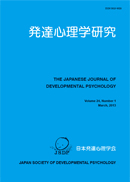
- Issue 4 Pages 169-
- Issue 3 Pages 105-
- Issue 2 Pages 55-
- Issue 1 Pages 1-
- |<
- <
- 1
- >
- >|
-
Akie Hayashi, Motoyuki Nakaya2020 Volume 31 Issue 2 Pages 55-66
Published: 2020
Released on J-STAGE: June 20, 2022
JOURNAL FREE ACCESSThis study contributes to the literature on the relation between situational help-seeking styles and school adjustment. The aim of this study was to develop measures of how high school students seek help from peers or teachers and to investigate how these autonomous and dependent differences influence school adjustments. A questionnaire on help-seeking styles and school adjustment was completed by 453 high school students (227 males, 221 females, and 5 who did not reveal their gender) aged 15 to 18 years. Factor analysis showed that each help-seeking scale had two factors. The reliability was established by a Cronbach's alpha (α=.65~.91), and the construct validity and content validity were established at a given level. An analysis of variance indicated that an autonomous help-seeking style was positively associated with various situations such as academics, career, etc., while a dependent help-seeking style in social relationship situations was positively associated with school adjustment. These results indicate that a dependent help-seeking style has a negative effect in academic domains but may have a positive effect in social relationship domains.
View full abstractDownload PDF (724K) -
Keigo Minakuchi, Masamichi Yuzawa2020 Volume 31 Issue 2 Pages 67-79
Published: 2020
Released on J-STAGE: June 20, 2022
JOURNAL FREE ACCESSIn this study, we examined the relationship between the instructional design of a science class in junior high school and the behavior of students in that class who had poor working memory. Three children with poor working memory and two with average working memory were selected from each of two classes and were observed in science and social science classes. One of the science classes was designed in a way that a summary of the subject matter was introduced by the teacher before the class began. The students were required to copy the contents of blackboard into their notebooks while the teacher wrote. The other science class was designed in the usual manner, in which the same teacher first posed a question to the students at first and helped them deduce the solution. In the experimental condition, it was found that students with poor working memory participated in the class activities to the same extent as students with average working memory. It was suggested that when knowledge was presented before the lesson, students with poor working memory could better understand the function of the lesson activities, which improved their participation in class.
View full abstractDownload PDF (820K) -
Keiko Itoh, Tetsuya Yasuda, Harumi Kobayashi, Eiko Takada2020 Volume 31 Issue 2 Pages 80-90
Published: 2020
Released on J-STAGE: June 20, 2022
JOURNAL FREE ACCESSThis study examined whether children with autism spectrum disorder (ASD) could determine the intentions of others' utterances. In the experiment, 17 ASD children and 13 typically developing (TD) children were asked to interpret a speaker's intentions in a video stimulus depicting a mother–son interaction. Although both ASD and TD children had difficulties in interpreting jokes and irony, both groups identified differences between the literal and intended meanings of the speakers' utterances. Evaluation of the participants' eye gaze data revealed that ASD children focused on context-related objects for a longer time than TD children, but TD children looked longer at other objects. Gaze frequencies for both types of objects were higher in TD children than in ASD children. ASD and TD children focused on the speaker's eyes for equally long time. This study suggested that if the related information is saliently presented, ASD children can understand a speaker's intentions. Moreover, helping ASD children to pay attention to potentially important but implicit contextual information may be important for improving their overall comprehension of verbal cues.
View full abstractDownload PDF (1035K) -
Ifu Migiwa, Atsushi Oshio2020 Volume 31 Issue 2 Pages 91-97
Published: 2020
Released on J-STAGE: June 20, 2022
JOURNAL FREE ACCESSPrevious research shows that intelligent curiosity motivates intellectual activity. Such curiosity is associated with the health of mind and body throughout life. The present study examines age and gender differences in epistemic curiosity among Japanese adults. Participants were 4,376 Japanese adults (2,896 men) who participated in an online survey. Their mean age was 51.8 years. Hierarchical multiple regression analyses indicated that epistemic curiosity differs with age and gender. Diverse curiosity shows a curvilinearly increase with age while specific curiosity increases linearly with age. Men show higher diverse curiosity than women, whereas no gender difference is observed for specific curiosity. These results are discussed with reference to previous studies showing relationships between epistemic curiosity and openness to new experience.
View full abstractDownload PDF (683K)
-
2020 Volume 31 Issue 2 Pages 102
Published: 2020
Released on J-STAGE: September 23, 2020
JOURNAL FREE ACCESSDownload PDF (496K)
- |<
- <
- 1
- >
- >|